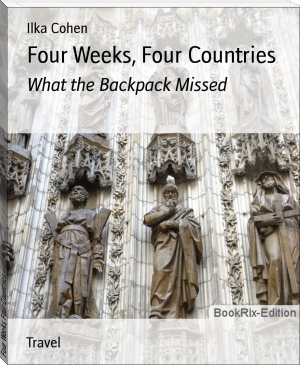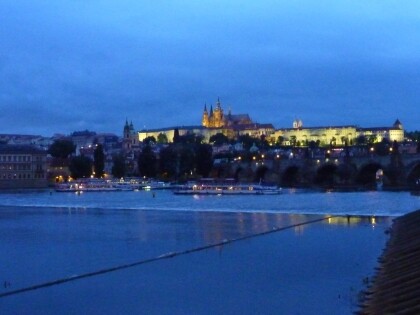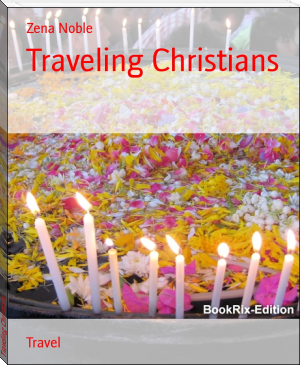Four Weeks, Four Countries, Ilka Cohen [manga ereader .TXT] 📗

- Author: Ilka Cohen
Book online «Four Weeks, Four Countries, Ilka Cohen [manga ereader .TXT] 📗». Author Ilka Cohen

German Interlude (June 5 to 9)
Five days remained before our real vacation within the vacation – a week in Spain. Time to unwind, unpack, take care of mail and photos and shopping and errands. To see Andrea and go to Leipzig’s city festival with Conny and enjoy some good music – Kai Niemann, a young Goth band named “Down Below” that we both liked best and the highlight of the day, Peter Schilling, whom I remembered from the days of Neue Deutsche Welle in the 80s. Everybody else did, too, so people were singing along in a loud chorus.
Five days without train rides apparently were too much, so we squeezed in a day visit in Berlin to meet Maureen and my mother. I was so anxious not to oversleep that I accidentally got up an hour too early and only noticed my error after the morning shower. Maureen was getting ready for her move back to the USA and to discard most of her possessions. Which meant we returned with way more books and CDs than planned, and I couldn’t pass by the onion-pattern porcelain from Thuringia either. Which is now practically a family heirloom: My grandmother had given it to my mother in the 70s – a popular present to send from the East to the West then -, who had passed it on to Maureen.
Maureen had matured over the last few months, looking slimmer, wearing better-fitting clothes, sporting no longer chewed down fingernails for the first time since she was three and a professional haircut. And just coming across as more focused and adult. Well, she would turn 24 soon, my age when I gave birth to her. Strange thought. When we said goodbye this evening, it was with the knowledge that we would meet again in Spain in just a couple of days, making us feel like a very international and well-traveled bunch indeed.
Why Spain, you might ask? Well, the Iberian peninsula was the one big white area left on my European travel map. And our finances called for a vacation week under 300 Euro per person. Which left the Turkish Riviera and various places in Spain. The one we settled on, Isla de Canela, was Aaron’s find. A small resort right next to the Portuguese border, at the Costa de la Luz, much less overrun than the Costa de la Sol or Mallorca. The hotel was new, and the available reviews seemed to indicate that only Spanish tourists went there. Sounded enticing. We had studied the travel guide and an art history book of Andalusia to get into the spirit of the place, of which I had otherwise very little preformed concepts to be confirmed or disappointed.
Our first vacation day was, as so often, mainly a travel day. We took an early train from Leipzig to Bremen to be at the airport with plenty of time to spare. Only we had planned without the German railway system. The train, up to that point only mildly late, stopped in Nienburg, about 70 km from Bremen. Nothing happened for about 45 minutes, at which point an announcement was made about a “people-involving accident” at the tracks. In Bahn jargon, this seems to be the term when somebody has been run over by a train, whether accidentally or as a suicide. The conductor informed us that nothing would move for the next 2-3 hours. An alternative connection would get us to Bremen at 3:41 p.m. – 10 minutes after the departure of our plane. What to do? We made a quick exit from the train to the taxi stop in front of the station. Only one passenger had been faster as we, so we got the second taxi. Driven by the owner of the local taxi company himself. Who proceeded to call all his drivers and send them to the station while driving us towards Bremen. A happy profitable day for his enterprise, as he charged 90 Euro for the ride. Painful for us and not made easier by the old guy going on and on about the more than 40 times he has been on the Canary Islands, his latest South Africa trip, his 3500000 Euro RV (which they don’t use very often so his wife will get a break from having to make the beds and cook during vacation), about the three months vacation he can take every year, his participation in the Steuben Parade in the USA, etc. In contrast to that, we are a family of paupers but, hey, we are pretty happy, too.
As small comfort, a nice sales woman at the Bremen airport sold Micah his döner for employee discount after I told her of our inauspicious start into the holiday week.
The 3 ½ hours flight was on time and typical Ryanair – nothing is free, no pre-assigned seats, advertisement everywhere. In fact, after pointing out that this was a non-smoking flight, the flight attendants immediately started to hawk smokeless electronic cigarettes for those who could not stand the nicotine withdrawal. Most of the flight path was hidden under clouds, but the skies cleared in time to let us enjoy the approach to Faro along the Spanish and Algarve coast. Long sand beaches, rivers and estuaries, it looked promising. We picked up our rental car, a little black Renault and found Hotel Playamarina in Isla de Canela without problems thanks to our Tom-Tom and after about an hour’s drive through a rather Californian-looking landscape.
The hotel is part of a vacation resort, hotels, timeshares, restaurants and stores. All very new and rather empty, apparently a victim of the Spanish version of the real-estate bubble. The wide promenades had the feeling of a ghost town in the evening. What tourists there were seemed to prefer the old fishing village at Punta Moral across the river. Our hotel apartment might have been intended as a timeshare, too. It was spacious enough and well-equipped. A living and dining room with couch bed for the boys, a kitchen, bathroom and a bedroom for Aaron and me. It even had a washing machine. The window looked out to the pool and the ocean beyond it.
After settling in, we followed everybody else’s lead and explored the fishing village where a village festival had just started up. We ate in one of the many little restaurants. Local seafood, except for Marcus who played it safe and ordered hamburger. To his disappointment, it was more akin to a spam burger, an experience repeated elsewhere. Spain is not a burger nation. But the fish is great, the wine cheap, and we even had musicians going around playing some flamenco tunes on accordion and guitar. I finished the evening with a solitary walk at the very dark beach, cut short by a rain shower. The forecast for the next couple days promised more of that and rather cool temperature. Even in Andalusia, summer had not yet arrived.
Eager to explore the new country, I was up and around way before anybody else seemed overly willing. The hotel complex included a small grocery store where we got some breakfast supplies. Spanish pastry has interesting similarities to Mexican – only slightly sweetened, rich in egg and fat and filling. I had chosen the day’s route, a tour to several (relatively) close towns and to the Doñana National Park. We passed by Huelva, which, while being a very old place, going back to Phoenician times, has little preserved of this illustrious past and is mainly a modern industrial center. Instead we visited the smaller and picture-pretty Moguer. White-washed houses with iron balconies in narrow streets, ceramic tile decorations on many walls. Very white and clean and freshly painted, quite a different impression than the romantic sandstone crumble of Southern Italy or Malta. It was quieter, too, though that might have been due to the fact that this was no tourist destination, just a little Spanish town known mainly for the fact that Columbus prayed a night away at the local monastery (St. Clara) and his captain Pinzon is buried here. As already during the drives from Faro and to Huelva, we marveled at the many stork nests everywhere, including on the towers of the monastery.
We stayed on the Columbus trail and next went to Palos de la Frontera, hometown of two of Columbus’ captains and half his crew and where the ships were built also. The great discoverers from small-town Andalusia. And another Columbus location followed: Monasterio de la Rabido. A dejected Columbus stayed here for some time after the Portuguese king had rejected his crazy plans to sail west. A local priest provided comfort and encouragement until the discoverer was ready to try his luck with the Spanish royals instead. There are Columbus monuments at all three places. La Rabido seems well visited by school classes and tourist groups and is surrounded by beautiful gardens and an international university campus. We harvested what we thought were limes from the trees for our drinking water. Later we discovered that these were rather unripe oranges but it still worked as refreshment.
Now we followed the coast, with the Atlantic mostly hidden behind high dunes, till Matalascañas. Another new and smallish resort with an inviting beach. There we rested and became acquainted with the Atlantic waters, mostly just jumping around in the





Comments (0)